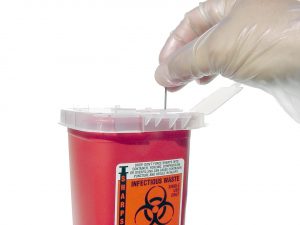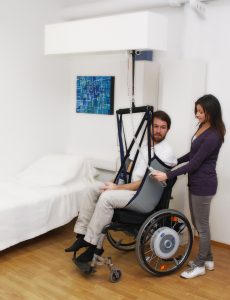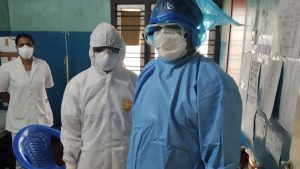5.9 Environmental Safety
Open Resources for Nursing (Open RN)
In addition to promoting safety for clients and their families, it is important for nurses to be aware of safety risks in the environments and to take measures to protect themselves. Common safety risks to nurses include sharps injuries, exposure to blood-borne pathogens, lifting injuries, and lack of personal protective equipment (PPE).
Workplace Safety
The World Health Organization (WHO) defines a healthy environment as a place of physical, mental, and social well-being supporting optimal health and safety. The American Nurses Association (ANA) created the Nurses’ Bill of Rights, a document that sets forth seven basic principles concerning expectations for workplace environments. One of the ANA principles states, “Nurses have the right to a work environment that is safe for themselves and their patients.”[1] Environmental Health is also one of the ANA Standards of Professional Performance. This standard includes “creating a safe and healthy workplace and professional environment.”[2]
Preventing Sharps Injuries and Blood-Borne Pathogen Exposure
Exposure to sharps and blood-borne pathogens is a critical safety issue that nurses face in the workplace.[3] Blood-borne pathogen exposure can cause life-threatening illnesses such as hepatitis B, hepatitis C, and HIV. Regulations and laws, such as the Blood-borne Pathogen Standard from the Occupational Safety and Health Administration (OSHA) and the Needlestick Safety and Prevention Act of 2002, have been effective in significantly reducing sharps injuries and blood exposures among health care workers. Areas covered by these regulations include sharps disposal practices, evaluation and selection of safety-engineered sharps devices and personal protective equipment (PPE), training, record keeping for needlestick injuries, hepatitis B vaccination, and post exposure follow-up. Medical device manufacturers have also played an important role in reducing sharps injury risks to health care workers by developing innovative safety-engineered technology, such as needleless IV access devices.[4] While substantial progress has been made to reduce injuries, preventable sharps injuries and blood exposures continue to occur in health care settings. According to the Centers for Disease Control and Prevention (CDC), around 385,000 sharps-related injuries occur annually among health care workers in hospitals, but it has been estimated that as many as half of injuries go unreported.[5] See Figure 5.12[6] for an image of a sharps container used to prevent sharps-related injuries.

If you do experience a sharps injury or are exposed to the blood or other body fluid of a client, follow agency and school policy and immediately follow these steps according to the injury site[7]:
- Wash puncture and small wounds with soap and water for 15 minutes.
- Apply direct pressure to lacerations to control bleeding and seek medical attention.
- Flush mucous membranes with water.
- Report the incident to your instructor or supervisor.
- Seek medical care to determine your risk associated with the exposure.
Safe Client Handling
Back injuries and other musculoskeletal disorders can be caused by one bad client lift or from the daily wear and tear of manually lifting clients. At least 56% of nurses have reported pain from musculoskeletal disorders that were exacerbated by requirements of their job. Consequences of these injuries can be devastating to nurses and their careers; musculoskeletal injuries related to client handling are responsible for more lost work time, long-term medical care needs, and permanent disabilities than any other work-related injury. Even using proper body mechanics and the use of gait belts can result in client handling injuries in nurses and health care workers. The ANA has established safe patient handling and mobility initiatives with the goal of complete elimination of manual patient handling.[8] See Figure 5.13[9] for an example of safe client handling equipment.

View these videos on safe client handling and mobility from the ANA:
Personal Protective Equipment
The Occupational Safety and Health Administration (OSHA) requires employers to provide personal protective equipment (PPE) to their workers and ensure its proper use.[12] In health care settings, the use of PPE includes gloves, gowns, goggles, face shields, and N95 respirators according to a client’s condition. Health care workers rely on personal protective equipment to protect themselves and their clients from being infected and infecting others. It is vital to follow agency procedures regarding PPE and transmission precautions to avoid exposure to infectious disease. See Figure 5.14[13] for an image of health care team members wearing PPE. Unfortunately, the COVID-19 pandemic created global shortages of PPE, resulting in many nurses and health care workers being exposed to the fatal disease. The ANA continues to advocate for adequate PPE for nurses in their work environments. Review additional information about PPE using the hyperlink below.

Fire Safety
Health care workers are required to understand fire safety in terms of what to do in the event of a fire, where fire alarms and fire extinguishers are located and how to access them, and where fire doors and fire exits are located. Fire safety is such a crucial aspect of safe client care that The Joint Commission and Centers for Medicare and Medicaid have mandated that all health care facilities receiving Medicare or Medicaid reimbursement must have a fire response plan, fire safety training for staff members, and functioning fire response equipment, such as fire alarms, fire extinguishers, overhead sprinkler systems, and clearly identified fire exit doors. The Joint Commission requires that facilities routinely conduct fire alarm drills as a means of practicing what to do in the event of a fire. These drills must be audited and documented with areas for improvements noted and addressed.[14]
RACE and PASS
Fire safety revolves around the acronyms RACE and PASS. RACE is an acronym that tells people what to do in the event of a fire. PASS is an acronym that tells people how to use a fire extinguisher correctly. Both acronyms are described below.
RACE stands for Rescue, Activate, Confine, and Extinguish[15]:
- Rescue: Rescue anyone in immediate danger. This includes removing clients from the immediate vicinity of the fire, as well as yourself. Maintain your safety while rescuing clients so you do not become a fire victim. This becomes especially important to keep in mind if the fire is between you and the client.
- Activate: Activate the fire alarm. This allows others to realize there is a fire or potential fire so that safety measures can begin immediately. Sometimes the activate step is also stated as “Alarm.”
- Confine: Confine the fire by closing doors and windows. This includes closing fire doors to help prevent the fire from breaching one fire zone and encroaching on another.
- Extinguish or Evacuate: Extinguish small fires if possible. Again, maintain your safety before trying to extinguish a fire. If the fire cannot be easily extinguished, then evacuate the fire zone or the building if necessary.
PASS stands for Pull, Aim, Squeeze, and Sweep[16]:
- Pull: Pull the pin on the fire extinguisher handle. This action is necessary to allow the handle to be depressed and allow fire extinguisher contents to be released.
- Aim: Aim low towards the base of the fire with the fire extinguisher nozzle or hose. It is important to aim the fire extinguisher contents to the base of the fire because this is what will extinguish the fire through smothering. The top part of the fire will not be smothered by the fire extinguisher contents because it is too large and spread out
- Squeeze: Squeeze down on the handle of the fire extinguisher to depress it and allow contents to be released from the extinguisher.
- Sweep: Sweep the hose or nozzle from side to side as the fire extinguisher contents are being sprayed on the base of the fire. This helps to fully cover the base of the fire in the hope of extinguishing it. Continue sweeping the fire extinguisher nozzle, spraying contents at the base of the fire until the fire is extinguished, or the fire extinguisher is empty. If the fire reignites, begin the steps of RACE and PASS again.
Safety Data Sheets
Safety Data Sheets (SDS), formerly referred to as Material Safety Data Sheets (MSDS), are hazardous communication sheets that let workers know certain information about chemicals they encounter in the workplace. OSHA requires that SDS’s are readily available and easily readable for each chemical in the workplace. SDS include the following mandatory information[17]:
- Section 1: Identification of the chemical and recommended uses, along with the contact information of the supplier.
- Section 2: Hazard(s) identification, classification of the chemical, and warning information about the hazards present.
- Section 3: Composition and information about ingredients contained in the product, including the chemical name, concentration, and impurities or stabilizing additives that may be present in the product.
- Section 4: First aid measures, including initial care for individuals who have been exposed to the chemical by varying routes.
- Section 5: Firefighting measures, including type of extinguishing equipment required and hazardous combustion products produced if the chemical burns.
- Section 6: Accidental release measures, including and appropriate response to spills or leaks and associated cleanup recommendations.
- Section 7: Handling and storage recommendations for the chemical.
- Section 8: Exposure controls and personal protection required for the chemical.
- Section 9: Physical and chemical properties of the substance.
- Section 10: Stability and reactivity hazards of the chemical.
- Section 11: Toxicological information, including health effects of exposure to the chemical and whether these are immediate, delayed, or chronic effects. Symptoms associated with exposure are also included.
Read more about SDS requirements in this OSHA Brief.
Explore the Healthy Work Environment web page by the American Nursing Association (ANA) for additional strategies that promote safe work environments for nurses, including the Nurses’ Bill of Rights and ways to put this plan into action.
- American Nurses Association. (n.d.). Healthy work environment. https://www.nursingworld.org/practice-policy/work-environment/ ↵
- American Nurses Association. (2021). Nursing: Scope and standards of practice (4th ed.). American Nurses Association. ↵
- American Nurses Association. (n.d.). Healthy work environment. https://www.nursingworld.org/practice-policy/work-environment/ ↵
- American Nurse. (2012). Moving the sharps safety agenda forward: Consensus statement and call to action. https://www.myamericannurse.com/moving-the-sharps-safety-agenda-forward-consensus-statement-and-call-to-action/ ↵
- American Nurses Association. (n.d.). Healthy work environment. https://www.nursingworld.org/practice-policy/work-environment/ ↵
- “Sharps Container.jpg” by William Rafti of the William Rafti Institute is licensed under CC BY 2.5 ↵
- Centers for Disease Control and Prevention. (2019). Stop sticks campaign. https://www.cdc.gov/nora/councils/hcsa/stopsticks/whattodo.html. ↵
- American Nurses Association. (2015). Safe patient handling & mobility: Understanding the benefits of a comprehensive SPHM program [Brochure]. https://www.nursingworld.org/~498de8/globalassets/practiceandpolicy/work-environment/health--safety/ana-sphmcover__finalapproved.pdf ↵
- “User-Integra-lifter1.jpg” by Integracp is licensed under CC BY-SA 3.0 ↵
- American Nurses Association. (2015, July 7). Preventing nurse injuries [Video]. YouTube. All rights reserved. https://youtu.be/qJH-91w5PHA ↵
- American Nurses Association. (2016, April 6). ANA presents safe patient handling and mobility [Video]. YouTube. All rights reserved. https://youtu.be/Bss2VEvrdcw ↵
- United States Department of Labor. (n.d.). Personal protective equipment. Occupational Safety and Health Administration. https://www.osha.gov/personal-protective-equipment ↵
- “Healthcare_workers_wearing_PPE_03.jpg” by Javed Anees is licensed under CC0 1.0 ↵
- The Joint Commission. (2024). Fire protection: Clinical impact. https://www.jointcommission.org/resources/the-physical-environment/fire-protection/clinical-impact/ ↵
- Whitlock, M., & Boone, W. (2014). Improving fire safety in an ambulatory setting. Nursing 44(8), 67. https://doi.org/10.1097/01.NURSE.0000451537.40340.d0 ↵
- Whitlock, M., & Boone, W. (2014). Improving fire safety in an ambulatory setting. Nursing 44(8), 67. https://doi.org/10.1097/01.NURSE.0000451537.40340.d0 ↵
- OSHA. (2012). Hazardous communication standard: Safety data sheets. https://www.osha.gov/sites/default/files/publications/OSHA3514.pdf ↵
A place of physical, mental, and social well-being supporting optimal health and safety.
A mnemonic for actions to immediately take during a fire, standing for Rescue, Activate, Confine, and Extinguish.
A mnemonic for actions to take when using a fire extinguisher, including Pull, Aim, Squeeze, and Sweep.
Are hazardous communication sheets that let workers know certain information about chemicals they encounter in the workplace.

